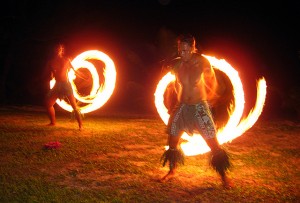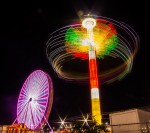Imagine capturing long bands of colorful light arching through your image, or the blur of colored lights on a Ferris wheel streaking across the sky at dusk, or the spinning torch of a fire dancer.

Fire Dancers
Light trails create interesting and fun images and are fairly easy to capture with a slow shutter in low light conditions. With the shutter held open longer, your camera can record the moving lights.
The key to photographing light trails is to keep everything that is not moving in clear focus, allowing the moving lights to make their blurred colored steaks. For variety you can vary the time of your exposure, which will change the length of the light trails. The slower the shutter speed the longer the light trail. Conversely, the faster the shutter, the shorter the light trails. Generally, shutter speeds from 1/8 second down to 1/30 second will create good results. Longer shutter speeds can be used but you risk introducing digital noise. Each camera model is different, and camera technology is always improving, so it would be worth your while to experiment with your shutter speed until you find the settings that create an acceptable balance between digital noise and light rail length for you.

Creating pictures with light trails takes some experimentation to find the right exposure, this is a time when using your cameras exposure bracketing feature is beneficial. Keeping your camera stationary is critical too, so use your tripod as well.
Tips for Light Trail Photography
- Add flash. Adding some flash while the shutter is open will put the subject on good focus and still have light trails. This is a great technique for capturing someone on a fairground ride or passing motorcycle.
- Vary your shooting position. Try different angles like a higher or lower vantage point, or moving in closer.
- Capture more images than you think you’ll need. Use exposure bracketing and you can choose from the best images.
- Minimize your head at night. Take as little equipment with you as you have to when shooting at night. Night shooting provides too many opportunities for the unscrupulous to take your gear while you are concentrating on your image.
- Exclude extraneous lights. Make sure your your doesn’t include bright stationary lights. Not only are they not interesting, bit they can cause lens flair and create an overexposure during long exposures.
- Expect to throw out some of your pictures. Long exposures take experimentation. Many of your light trail photographs just won’t be keepers.
Photography Credits
“Ferris Wheel at Night” by JJ Bowen
“Polynesian Fire Dancers” by Christina Spicuzza